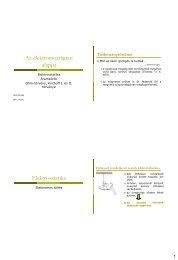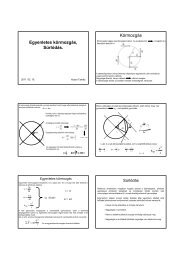Electromagnetic spectrum and the LASER
Electromagnetic spectrum and the LASER
Electromagnetic spectrum and the LASER
You also want an ePaper? Increase the reach of your titles
YUMPU automatically turns print PDFs into web optimized ePapers that Google loves.
E 2<br />
r(n)<br />
E 1<br />
Laser principles I. Stimulated emission<br />
Elementary radiative processes:<br />
1. Absorption 2. Spontaneous emission 3. Stimulated emission<br />
B 12<br />
•Frequency of transition:<br />
n 12=N 1B 12r(n)<br />
•�E= E 2-E 1=hn<br />
energy quantum<br />
is absorbed.<br />
N 2<br />
N 1<br />
Explanation: two-state atomic or molecular system<br />
E 1, E2 : energy levels, E2>E1<br />
r(n) : spectral power density of external field<br />
N 1, N2 : number of atoms, molecules on <strong>the</strong> given energy level<br />
B 12, A21, B21: transition probabilities between energy levels (Einstein coefficients), B12 = B21<br />
A 21<br />
•Frequency of transition:<br />
n 21=N 2A 21<br />
•E 2-E 1 photons<br />
radiate independently<br />
in all directions.<br />
r(n)<br />
B 21<br />
•Frequency of transition:<br />
n 21=N 2B 21r(n)<br />
•Upon external stimulation.<br />
•Field energy increases.<br />
•Phase, direction <strong>and</strong><br />
frequency of emitted <strong>and</strong><br />
external photons are identical.<br />
Laser principles III. Optical resonance<br />
End mirror<br />
Pumping<br />
Active medium<br />
d=n�/2<br />
Partially<br />
transparent mirror<br />
Resonator:<br />
•two, parallel planar (or concave) mirrors<br />
•Couples part of <strong>the</strong> optical power back in <strong>the</strong> active medium<br />
•Positive feedback -> self-excitation -> resonance<br />
Types of laser<br />
Based on active medium:<br />
1. Solid state lasers<br />
Crystals or glasses doped with metal ions; Ruby, Nd-YAG, Ti-zaphire<br />
Red - infrared spectral range; CW, Q-switched modes, high power<br />
2. Gas lasers<br />
Best known: He-Ne laser (10 He/Ne). Small energy, wide use<br />
CO 2 laser: CO 2-N 2-He mixture; �~10 µm; enormous power (100 W)<br />
Laser beam<br />
3. Dye lasers<br />
Dilute solution of organic dyes (e.g., rhodamine, coumarine); pumped with ano<strong>the</strong>r laser<br />
Large power (in Q-switched mode); Tunable<br />
4. Semiconductor lasers<br />
No need for resonator mirrors (internal reflection)<br />
Red, IR spectral range. Large CW power (up to 100 W)<br />
Beam characteristics not ideal. Wide use due to small size.<br />
Laser principles II. Population inversion<br />
•Amplification depends<br />
on <strong>the</strong> relative population<br />
of energy levels<br />
E 1<br />
E 0<br />
A<br />
F<br />
Active<br />
medium F+dF<br />
dz<br />
Thermal equilibrium Population inversion<br />
•Population inversion only<br />
in multiple-state systems!<br />
•Pumping: electric,<br />
optical, chemical energy<br />
1. Small divergence<br />
Parallel, collimated beam<br />
E 2<br />
Pumping<br />
E 0<br />
E 1<br />
E 0<br />
E 1<br />
Fast relaxation<br />
Metastable state<br />
Properties of laser<br />
2. High power<br />
In continuous (CW) mode: tens, hundreds of watts (e.g., CO 2)<br />
Q-switched mode: instantaneous power is enormous (GW)<br />
Large spatial power density due to small divergence<br />
3. Small spectral width<br />
“Monochrome”<br />
Large spectral power density<br />
4. Polarized<br />
5. Possibility of very short pulses<br />
ps, fs<br />
Laser transition<br />
6. Coherence<br />
phase equivalence, ability for interference<br />
Temporal coherence (phase equivalence of photons emitted at different times)<br />
Spatial coherence (phase equivalence across beam diameter)<br />
4



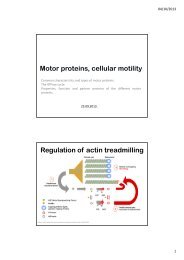
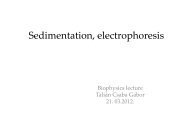
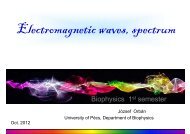

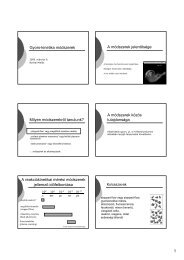


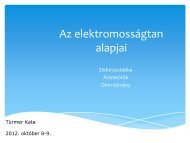



![Microsoft PowerPoint - Intermedier filamentumok [Kompatibilis m\363d]](https://img.yumpu.com/17119137/1/190x135/microsoft-powerpoint-intermedier-filamentumok-kompatibilis-m363d.jpg?quality=85)
